Welcome to Wikipedia (Bookshelf)/2013 edition/text
To produce a print version in your language, please see the localization guide for Editing Wikipedia.
- See also: wikisource:Editing Wikipedia
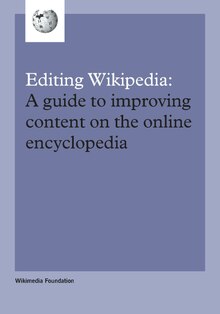
p. 1: Front cover
Concept: A Wikipedia editor (TBD)'s photograph accompanies the entire brochure and offers guidance and explains concepts. This editor should be a local community member from the language Wikipedia in which the brochure is translated (so an English Wikipedian for English, an Arabic Wikipedian for Arabic, etc.).
Vikipēdijas labošana
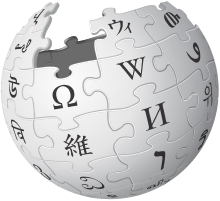
Pamācība satura uzlabošanai tiešsaistes enciklopēdijā
Es esmu vikipēdiste kopš 2004. gada. Es galvenokārt to papildinu tāpēc, ka man patīk palīdzēt radīt brīvu, uzticamu uzziņu avotu visai pasaulei. Es ar lielāko prieku palīdzēšu arī Jums apgūt veidus, kā to papildināt, lai arī jūs varētu pievienot savas zināšanas un padarītu Vikipēdiju labāku.

Note: reason for contributing can change based on which editor we use's actual reasons for contributing.
p. 2: Intro (inside cover)

Imagine a world in which every single human being can freely share in the sum of all knowledge. That's our commitment.
This is the vision for Wikipedia and the other Wikimedia projects, which volunteers from around the world have been building since 2001. Bringing together the sum of all human knowledge requires the knowledge of many humans — including yours!
Ko Jūs varat apgūt
Šī pamācība pastāstīs, kā Jūs varat dot ieguldījumu Vikipēdijā, tā, lai Jūsu savās zināšanās varētu brīvi dalīties ar citiem. Jūs atradīsiet:
- Kas ir Vikipēdija un kā tā darbojas
- Kā izmantot Vikipēdiju
- Kā un kāpēc dot ieguldījumu Vikipēdijā
- Svarīgi noteikumi, kuri palīdz padarīt Vikipēdiju uzticamu
- Kā labot Vikipēdiju, izmantojot Vizuālo redaktoru un vikitekstu
- Pamācība soli pa solim satura pievienošanai
- Etiķete saziņai ar citiem dalībniekiem
Saīsnes
Want to see up-to-date statistics about Wikipedia? Type WP:STATS into the search bar as pictured here.

The text WP:STATS is what's known on Wikipedia as a shortcut. You can type shortcuts like this into the search bar to pull up specific pages.
In this brochure, we designate shortcuts as | shortcut WP:STATS.
p. 3: What is Wikipedia? / free content
Kas ir Vikipēdija?
Wikipedia — the free encyclopedia that anyone can edit — is one of the largest collaborative projects in history. With millions of articles and in hundreds of languages, Wikipedia is read by hundreds of millions of people on a regular basis.
A lot of content already exists on Wikipedia, but many important topics have poor coverage and some have no article at all. Wikipedia relies on contributors like you to keep information current, expand short “stub” articles, and create new articles on topics not already covered in your language Wikipedia. Contributions you make to Wikipedia can enlighten hundreds, thousands, or even millions of people worldwide.
When you make an edit to Wikipedia, you're joining a community of hundreds of thousands of people — Wikipedians — who have freely contributed their knowledge to Wikipedia. What Wikipedians are doing has the potential to change the world. But there’s still a very long way to go before we collect the sum of all knowledge. That’s why we need your help.

Kāpēc labot Vikipēdiju?



[this two-page spread is a large article screenshot, with callouts highlighting important elements of the interface]
Navigācija Vikipēdijas lapās
As you get started, it's helpful to familiarize yourself with the interface and how to navigate Wikipedia pages.

Izceltais saturs
Here you can find some of the best work on Wikipedia: articles, photographs and other content that meet the community's highest standards.
Palīdzība
Palīdzības lapas, tāpat kā rakstus, ir veidojuši Vikipēdijas dalībnieki.
Kopienas portāls
Kopienas portāls ļauj uzzināt, kas notiek Vikipēdijā, no jaunumiem, sadarbības projektiem līdz diskusijām par noteikumiem.
Rīki
Šī sadaļa satur noderīgus rīkus papildu informācijas iegūšanai par lapu un tās vēsturi.
Valodas
Šīs ir citas Vikipēdijas valodu versijas — no vairāk kā 280 — kurās ir raksts par šo pašu tēmu.
Valodas iestatījumi
Šie iestatījumi ļauj nomainīt izvēlnēs pieejamo valodu un izvēlēties tastatūras izkārtojumu.
Diskusija
Katram rakstam ir atbilstoša Diskusiju lapa, kur dalībnieki var atstāt komentārus un ieteikumus, apspriest izmaiņas un viens otram lūgt palīdzību.
Labot
Daudzi lasītāji nekad nav pamanījuši labošanas pogu, bet tā ir svarīgākā Vikipēdijas raksta daļa. Klikšķini uz pogas "Labot" lapas augšā, lai labotu visu rakstu vai arī uz kādas no saitēm, lai labotu konkrētu sadaļu.
Hronoloģija
The history of a Wikipedia article includes every contribution since it was created. You can see who changed what when, and compare any two versions side-by-side.
Izveidot kontu
If you haven't done so yet, create your account. With an account, you can keep track of your contributions, create a personal User page, and receive Notifications when other contributors reply to you or build on what you've done.
Meklēšana
Find articles by name, or find pages that include your search terms. You can also enter shortcuts (like "WP:HELP") to bring up specific pages that we reference throughout this brochure. A useful one is | shortcut WP:HELP.
p. 6-7: Contributors / ways of contributing /why to contribute
[This page is intended as a visual representation of the variety of ways different people contribute, why they contribute, and the diversity of contributors]
Ko dara vikipēdisti
Brīvprātīgie sniedz labumu vairāk kā vienā veidā. Šie ir piemēri, kuri ļauj Vikipēdijai pastāvēt.
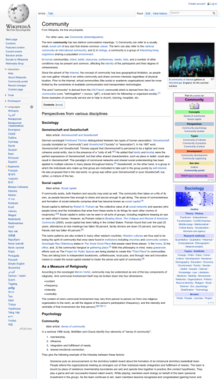
Pievieno jaunu tekstu un atsauces

Sagaida jaunpienācējus un atbild uz viņu jautājumiem

Uzrauga jaunos rakstus un nesenos labojumus
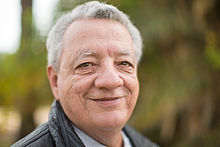
Apspriež Vikipēdijas noteikumus un palīdz risināt strīdus
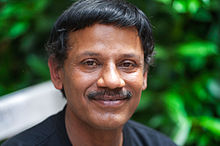
Izstrādā bezmaksas, atvērtā pirmkoda programmatūru, kura darbina Vikipēdiju

Augšupielādē fotogrāfijas un ilustrē rakstus

Uzlabo valodas lietojumu rakstos
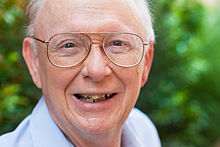
Liek studentiem labot Vikipēdiju vai palīdz viņiem apgūt pamatus Vikipēdijas Izglītības programmā

Pārskata rakstus un piedāvā ieteikumus uzlabošanai

Kāpēc labot Vikipēdiju?

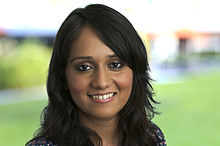
Es iemācījos runāt angliski, cīnoties ar vandalismu Vikipēdijā.

p. 8: Preparing to edit / content rules
Sagatavošanās labošanai
Vikipēdiju var labot ikviens, bet ir daži pamatnoteikumi. Šie ir daži no svarīgākajiem, kuriem jāseko, uzsākot labošanu:
Neitrāls skatu punkts
Vikipēdijā viss ir jāapraksta no neitrāla skatu punkta. Rakstā nedrīkst pieņemt nostāju, bet tam ir jāapraksta — precīzi un bez aizspriedumiem — visi nozīmīgākie skatu punkti par tēmu, kuri publicēti uzticamos avotos. Vikipēdijas rakstos neiederas argumentācija un propaganda.
Nekādu oriģinālu pētījumu
Simply put, Wikipedia is not a place to publish original ideas. Rather, you should summarize what others have published in reliable sources about the topic. Articles may not contain any new analysis, and they should not synthesize published materials to reach broader conclusions beyond what the individual sources say.
Autortiesības un plaģiātisms
Since all contributions are freely licensed, no editor owns any article; all of your contributions can and will be edited and redistributed. Except for brief quotations, copying content from copyrighted sources onto Wikipedia is not allowed. Whether direct copying or close paraphrasing, plagiarism and copyright violation are disruptive and time-consuming for volunteers to clean up. It’s important that all content you contribute to Wikipedia is written in your own words. (Public domain and freely licensed content may also be added to Wikipedia as long as it is properly attributed.)
Uzticami avoti
Information in Wikipedia needs to be verifiable, based on reliable published sources. You should include citations for the information you add to the encyclopedia, so that others can check it for themselves. The most reliable sources for Wikipedia are third-party sources with a reputation for fact-checking, such as books published by academic presses, peer-reviewed academic journals, and international newspapers. You should be using sources that represent significant viewpoints, rather than one-off studies or fringe work. Try to find the best and most reliable sources available on the topic.
Interešu konflikts
Ja Jums pastāv interešu konflikts par konkrētu tēmu — piemēram darba devēju vai pārstāvēto organizāciju — Jums būtu jāizvairās no ar to saistīto rakstu labošanas.
Šīs politikas un principus mēs esam izstrādājuši gadu gaitā tā, lai mēs būtu droši, ka Vikipēdija ir pēc iespējas uzticamāka un noderīgāka.

P. 9 Encyclopedic Writing Style
Kas ir enciklopēdiskais stils?
Writing in an encyclopedic style and a formal tone is important when adding new content to Wikipedia. Instead of essay-like, argumentative, or opinionated writing, Wikipedia articles should have a straightforward, just-the-facts style. Here are examples of the do’s and don’ts of encyclopedic writing.
Neatbilstoši
Britannica un enciklopēdiju nākotne
| “ | {{{2}}} | ” |
No kā jāizvairās
Neveidojiet jaunus esejas formāta rakstus vai sadaļas
Nestrukturējiet savu tekstu kā argumentāciju.
Neizmantojiet viltīgus tekstus (kā “vairums ekspertu ir vienisprātis” vai “daļa cilvēku apgalvo”).
Neizmantojiet sarunvalodu vai slengu.
Neizmanto izpušķojošus terminus (piemēram, “lielisks”, “neparasts” vai “bezbailīgs”).
Don’t inject personal opinion into the writing.
Neizmantojiet pārmērīgi sarežģītu valodu vai teikumu struktūru.
Atbilstoši
| “ | Kopš 1990. gadu sākuma Britannica ir saskārusies ar jauniem izaicinājumiem no digitāliem informācijas avotiem. Strauji mainīgās sfērās kā zinātne, tehnoloģija, politika, kultūra un modernā vēsture Britannica ir problēmas tikt līdzi laikam. Šo problēmu pirmais sistemātiski analizēja tās bijušais redaktors Volters Justs.[1] Lai arī Britannica šobrīd ir pieejama gan multimediju formā, gan Internetā, tās pārākumu ir izaicinājušas citas tiešsaistes enciklopēdijas kā Vikipēdija.[2] | ” |
Dariet
Izmantojiet vienkāršu valodu
Esiet īss
Citē avotus, lai pamatotu faktuālus apgalvojumus
Piedēvē viedokļus cilvēkiem, kas tos ir pauduši
Izveiries no secinājumiem, izņemot gadījumus, kad var norādīt precīzu avotu
p. 10: VisualEditor / structure of an article
[This page and the following page show edit mode for the same article in VisualEditor and wikitext, respectively. The VisualEditor side focuses on the structure of a typical article, while the wikitext side shows the wikicode syntax for typical page elements.




Labošana ar Vizuālo redaktoru
With VisualEditor, you can see what your changes will look like as you edit, so you can focus on the content. Just click on the parts you want to change and start editing.
Labošanas rīkjosla
Labošanas režīmā rīkjosla ļauj formatēt tekstu, atsauces, attēlus un īpašus lapas elementus, sauktus par veidnēm (piemēram, infokastes daudzu rakstu sākumā). Kad labošana ir pabeigta, nospiediet pogu "Saglabāt lapu".
Ievada sadaļa
The first sentence provides a definition of the topic, and the lead section goes on to summarize the key points covered in the article. This is the only section without a heading.
Attēli
Brīvi licencētus attēlus un citus multimediju failus Vikipēdijas rakstiem var pievienot no Vikikrātuves (Wikimedia Commons).
Citāti
Inline citations in the body of the article are used to show where the information in each part of the text came from. The citation details appear as footnotes at the end.
Veidnes
Atkalizmantojami fragmenti, saukti par veidnēm, tiek izmantoti, lai informāciju noformētu standarta formā un ievietotu tādas lietas kā paziņojumus lietotājiem par raksta problēmām.
Raksta pamatteksts
Headings — and sometimes sub-headings — break the article up into sections, and are used to generate the table of contents. Each section usually covers some significant aspect of the topic, so that readers can jump right to the information they are looking for.
Pielikumi un piezīmes
Pēc raksta pamatteksta seko sadaļas ar papildu informāciju, tādu kā saistītie Vikipēdijas raksti ("Skatīt arī"), piezīmes ar izmantotajiem avotiem ("Atsauces") un saraksts ar citām tīmekļa vietnēm, kura lasītāji varētu apmeklēt papildu informācijai ("Ārējās saites").
p. 11: Wiki markup
[This page consists of a simplified and excerpted version of the wiki markup for the same article as on the facing page. Most of the content is blurred out, but the example elements of markup are not. Callouts explain the most import markup syntax.]






Labošana ar vikitekstu
Wiki markup is the original form of editing Wikipedia articles (and on some browsers, it will be the only form available). It gives you precise control over the content and appearance of the page, once you understand how it works. Some of the underlying wiki markup for an article is pictured below. See how many of the corresponding elements you can find in the VisualEditor illustration.
Attēls
Double square brackets around the title of a photo from Wikimedia Commons will insert the image. Pipes separate optional parameters to control how the image is displayed. The most common way is with two parameters: the word “thumb” to use the standard thumbnail format, and a descriptive caption that appears beneath the image.
[[File:Example.jpg|thumb|caption]]
Treknraksts
Trīs apostrofi pirms un pēc teksta padara to par treknrakstu. Parasti pirmajā teikumā raksta temats tiek noformēts treknrakstā.
'''teksts treknrakstā'''
Citāts
Opening and closing ref tags are used to cite a source. An automatically-numbered superscript appears at the location of the ref tags, and the content appears as a footnote in the references section.
<ref> citāta teksts </ref>
Iekšējā saite
Dubultas kvadrātiekavas, kuras ietver terminu, veido saiti uz rakstu ar šādu nosaukumu. Pievienojot vertikālas svītriņas simbolu un tekstu pirms aizverošajām iekavām, var mainīt attēlojamās saites tekstu.
[[raksta nosaukums|teksts]]
Kursīvs
Divi apostrofa simboli uzsāk un nobeidz teksta segmetnu kursīvā.
''teksts kursīvā''
Virsraksts
A pair of double equals signs mark a line as a heading. Triple equals signs make a sub-heading.
==Virsraksts==
Veidne
Double braces are used for templates, which are reusable page elements that serve many purposes. The first item after the opening braces is the template’s name. Pipes separate the parameters, which are additional inputs that can change the way the template works or what it displays.
{{veidnes nosaukums|parametrs}}
Atsauces
Atsauču iezīme vai atbilstoša veidne norāda atsauču saraksta atrašanās vietu — visbiežāk sadaļā “Piezīmes” vai “Atsauces”.
<references />
Ārējā saite
Viena kvadrātiekava, kurai seko URL, atstarpe, saites teksts un aizverošā kvadrātiekava izveido parastu hipersaiti. Parasti tās izmanto tikai atsauču vai vai “Ārējo saišu” sadaļā.
[http://www.piemers.com teksts]
Kategorija
At the end of an article, double square brackets around a string that starts with Category: adds an article to the specified category. Categories organize Wikipedia articles into related sets.
[[Kategorija:Kaut kas]]
For more wiki markup help, see the cheatsheet on page 19 or visit the reference page | shortcut WP:MARKUP.
pp. 12-13: Adding content, step by step
Satura pievienošana soli pa solim
These images show how one contributor added new information to the article on Penny Cyclopaedia.
Šis raksts pirms labošanas...

...un raksts pēc izmaiņu saglabāšanas.

This image shows what the contributor added and the markup they used. Follow these steps and you too can add content to a Wikipedia article.
1. solis: Izvēlieties tematu, par ko vēlaties rakstīt.
2. solis: Atrodiet uzticamu avotu, kurš apraksta tematu labāk kā esošais Vikipēdijas raksts.
3. solis: Jautrākā daļa. Klikšķiniet uz pogas "Labot"!
4. solis: Pievienojiet kādu trūkstošo informāciju. Izmantojot atrasto avotu, apkopojiet vēlamo informāciju un pievienojiet, noformulējot to saviem vārdiem.
5. solis: Sava jaunā teksta fragmenta beigās pievienojiet atsauci. Labošanas rīkjoslā — neatkarīgi no tā, vai izmantojiet vikitekstu vai Vizuālo redaktoru — klikšķiniet uz ikonas "citēt", lai atsauktos uz savu avotu.
6. solis: Laukā "Izmaiņu kopsavilkums" pievienojiet īsu aprakstu par labojumā veiktajām izmaiņām.
(With VisualEditor, you’ll be prompted for an edit summary after you click Save page.) The edit summary helps other editors understand what you are doing.
7. solis: Tagad ir laiks saglabāt izmaiņas. Neaizmirstiet noklikšķināt uz pogas "Saglabāt lapu".

Neuztraucieties. Ja jūs pieļaujat kļūdu, vienmēr var veikt vēl vienu izmaiņu vai atjaunot raksta iepriekšējo versiju.
p. 14: Interacting / user pages / user talk
Lietotāju lapas un diskusiju lapas
Wikipedia has other types of pages beyond articles. As you start editing, you might also want to create your User page to let others get to know you a little bit.

At the top right (if you are logged in) you will see your username, which you can click to reach your User page. Links to pages that do not exist — such as your User page if you have not created it yet — are colored red, instead of the typical blue.

If you click the Create button on one of these pages, you can start from a blank page. A User page is a place to write a little bit about yourself, to give other contributors an idea of who you are and what you’re interested in. You can share as much or as little as you like.
When you Save the page, your red link will turn blue!

You also have a User Talk page, where other contributors can leave messages for you. If you want to contact another contributor, you can navigate to their Talk page and leave a message at the bottom.
You should sign your messages on Talk pages; clicking the Signature button in the edit toolbar will insert four tildes ( ~ ~ ~ ~ ), the special wiki markup for inserting your username along with the date and time of your message.

Šī ikona labošanas rīkjoslā ir paraksta poga
p. 15: article talk / etiquette
Saziņa ar kopienu
Every article has its own Talk page, too. These Talk pages can be used to make suggestions, post new sources, point out problems, and discuss changes that contributors disagree about.
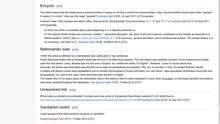


One important guideline for community discussions on Wikipedia is to be respectful and civil. Even if you get into disagreements, you should assume good faith on the part of other contributors. They almost always have the same goal you do — to make Wikipedia better. Keep the discussions focused on content, rather than making them about individual contributors.
p. 16 mobile editing
Mobile editing
In addition to the traditional desktop interface, Wikipedia has a streamlined mobile version that you can use to both read and edit. Just visit Wikipedia on your smartphone or tablet, then log in.

Show and hide menu options

Labot rakstus
Augšupielādēt un pievienot fotogrāfijas
Pievienot rakstus uzraugāmajam sarakstam
Pārbaudīt savus paziņojumus
Kāpēc labot Vikipēdiju?
Man patīk sajūta, ka es dodu ieguldījumu kam lielākam kā es pats.



p. 17 more about English Wikipedia
[The idea is that this is a page with a pretty simple layout that can be rewritten for each language to highlight whatever is important for that version of Wikipedia that isn't already covered.)
More about English Wikipedia
Each language version of Wikipedia is different (although there is a lot in common across languages as well). These are some of the things specific to English Wikipedia that you may find useful.
Creating your first article
Starting a new article on English Wikipedia — and making sure it doesn’t get deleted — can be tricky. For a detailed guide on creating your first article, see | shortcut WP:FIRST .
Wikipedia Signpost
The Signpost | shortcut WP:SIGNPOST is a weekly community newspaper, covering Wikipedia-related news and research, important discussions, new Featured content, and more. You can even subscribe to have it delivered to your Talk page each week.

Nebrīvu attēlu augšupielāde
In general, only freely licensed or public domain images can be used to illustrate Wikipedia articles, and these should be uploaded to Wikimedia Commons (commons.wikimedia.org). However, limited exceptions are allowed on English Wikipedia under the non-free content rules | shortcut WP:NONFREE for things like album covers. Non-free images uploaded to Wikipedia without a clear justification under the rules will be deleted.

Vikiprojekti
WikiProjects are groups of contributors who have a common interest when it comes to editing Wikipedia. Browsing the existing WikiProjects | shortcut WP:WIKIPROJECT and joining ones that interest you can be a good way to find things you want to work on and connect with other Wikipedians.
[WikiProject Directory image]
Wikipedia 1.0 assessments
WikiProjects on English Wikipedia have a system for rating the quality and importance of articles, known as the Wikipedia 1.0 assessments | shortcut WP:ASSESS . For quality, these ratings go from Stub (just the beginnings of an article) to Start to C-class to B-class, and then the formally reviewed ratings of Good article, A-class, and Featured article.
You can see the ratings for an article at the top of its Talk page, and most WikiProjects maintain a table showing how many articles related to that WikiProject have each rating. Browsing WikiProjects for Stub and Start articles is a good way to find new topics to work on.
p. 18: article quality / additional resources
Vikipēdijas rakstu kvalitātes izvērtēšana
The quality of Wikipedia articles varies widely; many are very good, but some lack depth and clarity, contain bias, or are out of date. In general, high-quality articles have these elements:
- a lead section that gives an easy-to-understand overview,
- a clear structure,
- balanced coverage,
- neutral content, and
- reliable sources.
Additional information about article quality is available by consulting the “Evaluating Wikipedia” brochure (see below).
Papildu resursi
Evaluating Wikipedia: Tracing the evolution and evaluating the quality of articles"
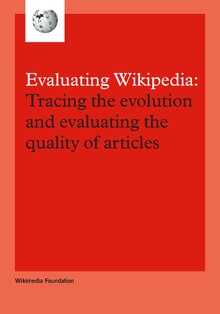
How articles evolve, elements of good quality articles, and signs of poor quality articles are all covered in this guide.
Illustrating Wikipedia: A guide to contributing content to Wikimedia Commons

A companion guide covering Wikimedia Commons, the media repository for images used on Wikipedia. The brochure covers what Wikimedia Commons is, how to upload files, how to use files, and the basics of free licenses.
Instructor Basics: How to use Wikipedia as a teaching tool

This brochure offers best practices for educators looking to assign students to contribute to Wikipedia as part of their course curriculum.
p. 19: wiki markup cheatsheet
Wiki markup cheatsheet
These examples cover the formatting needed most often when editing Wikipedia articles with wiki markup. For more help, see | shortcut H:MARKUP .
Apraksts
Raksta
Iegūst
Kursīvs
teksts kursīvā
Treknraksts
teksts treknrakstā
Sadaļu virsraksti
Virsraksta teksts
Saite uz citu Vikipēdijas lapu (iekšējā saite)
Denis Diderot
Iekšējā saite ar atšķirīgu tekstu
Link to another website
Nenumurēts saraksts
- Vikipēdija
- Enciklopēdija
Numbered list
- A - Azymites
- B - Cézimbra
Attēls ar parakstu
[[Attēls:Piemērs.jpg|thumb|Paraksta teksts]]
Paraksta teksts
Paraksts un laika zīmogs (diskusiju lapām)
~~~~
Lietotājvārds (diskusija) 19:50, 11. decembrī, 2013 (EET)
To make a citation
What you type
What you get
Insert a citation
Page text. <ref>[http://example.org Example.org], more text.</ref>
Page text.[1]
Display citation footnotes
<references />
1. ^ Example.org, more text.
p. 20: back cover / glossary
labojuma kopsavilkums
A brief explanation of an edit to a Wikipedia page, which helps other contributors follow the development an article and understand the intention of the edit.
brīva licence
A public copyright license that ensures the freedom to use and study a work, to make and redistribute copies of it, to make changes and improvements, and to distribute derivative works, by any person for any purpose. Wikipedia — and each individual contribution to it — uses the Creative Commons Attribution-ShareAlike license, which is a free license. See | shortcut WP:CC-BY-SA to learn more.
vēsture
The record of a Wikipedia page, accessible through the View history tab, that shows every edit made. Any two versions can be compared to see the specific differences (known as a diff), and previous versions can be restored.
markup
The special code used to format a Wikipedia page. See the cheatsheet (page 19) for the basics, or go to | shortcut H:MARKUP for more detail.
Notification
A message for you that shows up at the top of a Wikipedia page. If you want to let someone know you replied to them, you can create a Mention Notification by including a link to their User page in a signed Talk page message.
parametrs
A bit of text, separated from other bits with a pipe character (|), that is used to control how images, templates, and other wiki markup appear on a page.
aizmetnis
A short, undeveloped article with plenty of room for expansion. Adding content to stubs is a good way for new contributors to get started.
Diskusiju lapa
The discussion space for an article or other Wikipedia page, where you can talk about the contents of the page with other contributors.
veidnes
A way of automatically including the contents of one page within another. For instructions on using them, see | shortcut H:T .
Lietotāja lapa
The personal page of an individual contributor, which begins with "User:" followed by their username. Wikipedians can use their User pages to share information about themselves and their interests, list the articles they have worked on or want to work on, and much more.
Vikikrātuve (Wikimedia Commons)
The media repository for Wikipedia and many other wikis, where you can contribute freely licensed photos, diagrams, videos, and other media files for illustrating Wikipedia.
Vikipēdists
Kāds, kurš palīdz veidot Vikipēdiju. Biežāk izmatotie sinonīmi ir "lietotājs", "redaktors" un "kopienas dalībnieks".
All images from Wikimedia Commons are under a CC BY-SA license or public domain unless otherwise stated. The content contained within is available under the Creative Commons Attribution-ShareAlike License v.3.0 (http://en.wikipedia.org/wiki/Wikipedia:CC-BY-SA) or any later version.

The trademarks and logos of the Wikimedia Foundation and any other organization are not included under the terms of this Creative Commons license. Wikimedia Foundation, Wikipedia, Wikimedia Commons, MediaWiki, Wiktionary, Wikibooks, Wikidata, Wikisource, Wikinews, Wikiquote, Wikiversity, Wikivoyage, Wikispecies, and Meta-Wiki are pending trademark registration or are registered trademarks of Wikimedia Foundation.
Papildu informācijai, lūdzu, apskatiet mūsu preču zīmju politikas lapu, http://wikimediafoundation.org/wiki/Trademark_Policy.
For other questions about our licensing terms or trademark policy, please email legal@wikimedia.org
Deivida Pītersa (David Peters) dizains, EXBROOK
Portraits of Wikipedians by Karen Sayre, Adam Novak, and Victor Grigas. CC BY-SA 3.0